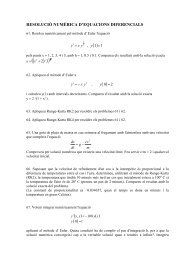Universitat de - Departament d'Astronomia i Meteorologia ...
Universitat de - Departament d'Astronomia i Meteorologia ...
Universitat de - Departament d'Astronomia i Meteorologia ...
Create successful ePaper yourself
Turn your PDF publications into a flip-book with our unique Google optimized e-Paper software.
160 Chapter 6. EVN and MERLIN observations<br />
Figure 6.3: Images of 1RXS J062148.1+174736 using the different arrays and with the<br />
parameters given in Table 6.4. The axes units are in mas. A (u, v)-tapering with a<br />
FWHM at 8 Mλ has been used to perform the combined EVN+MERLIN image.<br />
this source was observed it was below the horizon in SH. Therefore, the obtained<br />
beam size for the EVN image is larger than the ones obtained for the other sources,<br />
as can be seen in Table 6.4, hence providing lower angular resolution than in the<br />
other cases. A comparison between the VLA and MERLIN positions reveals that<br />
they are perfectly compatible within the errors, suggesting an extragalactic nature<br />
or a small proper motion if it turns out to be a galactic microquasar. Although the<br />
compactness of the source is not indicative of a galactic or an extragalactic origin,<br />
the exten<strong>de</strong>d optical counterpart, reported in Chapt. 5, suggests an extragalactic<br />
origin for this source. In fact, the <strong>de</strong>tected radio variability from 8 to 11 mJy within<br />
a week reported in Chapt. 5, is compatible with the compactness in an extragalactic<br />
object (see IDV phenomenon, Wagner & Witzel 1995).<br />
6.3.5 1RXS J072259.5−073131 and its bent one-si<strong>de</strong>d jet<br />
The images obtained at different resolutions are plotted in Fig. 6.4. The MERLIN<br />
image presents a compact structure with some elongation eastwards, while the EVN<br />
and combined EVN+MERLIN images show a clear one-si<strong>de</strong>d jet towards the east,<br />
with a slight bent towards the south at larger core separations. The closure phases<br />
clearly show that the source <strong>de</strong>parts from symmetry, with preferred emission to the<br />
east, both in the MERLIN and the EVN data sets. Two distinct components are<br />
present in the EVN image, at 9 and 17 mas from the compact core (P.A. of 89 and<br />
113 ◦ , respectively). Those components can be mo<strong>de</strong>l fitted with elliptical Gaussians,<br />
yielding flux <strong>de</strong>nsities of 3.7 and 2.8 mJy, respectively, for a core of 40.3 mJy.






